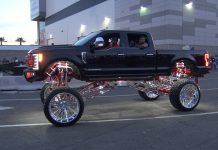Here’s the latest reader question, along with my reply!
To5 asks: Hello Eric. Longtime follower here from Australia. I have a 2000 Statesman RWD made by Holden (GM) that has a noise coming from the rear of the car. The noise is metal on metal. Rear suspension is IRS. Really loud and clunky on slow speed, largely disappearing after going at moderate or highway speeds. I have replaced all exhaust system mounts, and the right rear CV joints shaft. Also changed diff fluid, no metal present in the drained fluid. When I put in on a lift, and I spin the right rear wheel by hand, it moves smoothly. Now here is a mysterious clue. Four times I’ve put the car on a lift, and four times afterward for the next two days, the noise disappears, then returns. Yesterday I removed the driveshaft to replace the AT rear seal, and the noise disappeared. Today too no noise. My son thinks it’s a diff problem, I think the wheel bearing in the hub is the problem. But taking the load off the rear takes the pressure off of something. I cannot see any problems with the rear suspension and diff at all when the car is on the lift. Any clues? The diff has a mount bracket at the rear of the diff, so could that be a problem? The car drives normally otherwise.
My reply: The very first thing I would check is the U joint/driveshaft yoke. Then the rear wheel bearings/races. Physically inspect them, inner and outer. It’s possible there’s some issue with the ring and pinion, which I’d check if the other stuff checks out – but I would bet on the U joint/yoke or bearings/races first.
This stuff is process of elimination, starting with the simple/easy things to check first and then moving right along. Each possibility crossed off the list brings you one step closer to the cure!
Sometimes, a car is just “noisy” naturally. It can be tires, it can be exhaust. Swapping out the tires it has for a set that don’t sing can solve the problem. So can a quieter muffler. Another option is to add sound deadening material, such as second skin.
Hope you find the source – and get some peace!
. . .
Got a question about cars – or anything else? Click on the “ask Eric” link and send ’em in!
If you like what you’ve found here please consider supporting EPautos.
We depend on you to keep the wheels turning!
Our donate button is here.
If you prefer not to use PayPal, our mailing address is:
EPautos
721 Hummingbird Lane SE
Copper Hill, VA 24079
PS: Get an EPautos magnet (pictured below) in return for a $20 or more one-time donation or a $10 or more monthly recurring donation. (Please be sure to tell us you want a sticker – and also, provide an address, so we know where to mail the thing!)
My latest eBook is also available for your favorite price – free! Click here. 












Hello Eric. I finally have fixed the problem, almost 20 months and 12000 km later. It was weird but there were 2 noises at the same time. Steering and axle. The steering was the most serious so it got fixed first.
When we first tested the car, a friend rode in the back seat with the window open and heard the noise from the right side. He then sat on the left side of the car with the window open but could only hear a faint noise. This of course threw us off as we were looking for the noise on the right, when the defective cv joint was on the other side of the car.
I tried your clues. The wheel bearings in this car are the sealed units. On the way to solving the problem, I had to replace the metal tubes on the steering rack, severed by crumbling motor mounts that allowed the motor to sag onto the steering lines. Before this, months before I noticed that the car hesitated on putting the pedal to the floor. Much later I realized that this was due to the bad motor mounts, but only after replacing the mounts. After taking out the steering rack, I decided to renew the motor mounts due to the age and kilometres on the car. Were they ever decayed and crumbling. A trip to the local wrecker to exchange the proper rack resulted in the bloke telling me to check the mounts because if the mounts are sagging the motor can drop down onto the rack. Plus a lot more access to the mounts with the rack off the car. When I fixed the steering and mounts, the noise continued but with a different tone. I continued driving the car for the last 4 months.
2 weeks ago I talked to my local mechanic who thought the clutches in the lsd were acting up and he recommended an additive to add to the diff to reduce the noise. I could not find such a fluid in the local auto parts stores. I also checked the labels on all the diff fluids on display to make sure I had put in the correct fluid 2 years ago when I changed the diff fluid. I concluded that the diff fluid was not the problem. So I went to find the diff bloke locally that my son had dealt with. He said the left rear cv shaft coming out of the diff was broken and wouldn’t last much longer. I then stopped by the local Holden parts wrecker to get a used shaft. I put the shaft on the car and the noise has disappeared and the car rides a little smoother.
So after putting in the better part, I rolled the old shaft across the concrete floor. And heard a clicking noise from the inner CV joint. I pulled the boot off the inner shaft and was able to move the joint 40 mm sideways. I also noticed that the grease had dried out, and there were metal shavings everywhere. I have never seen an automotive joint move so much as that inner cv joint. I hope never to see that again either.
Had the noise been prominent on the left side at first, we would have fixed the problem on the first try. Thanks for your help and advice as it has finally been fixed. What an adventure, eh?
Hi To5!
These things are always . .. fun, eh? But it’s satisfying as a good ribeye (almost) when you finally do. I’m glad you finally did!
I had one myself about 15 years ago – one for the ages. It was right after I’d rebuilt/installed the 455 in the TA. It ran great but there was this odd rattle that I couldn’t source or figure out. I finally just decided to live with it as it’s an old car and old cars rattle. Part of the deal. Well, I found out what the problem was – inadvertently – a few months later, when I dropped the exhaust to replace the pipes with a new stainless set from Pypes. And guess what I found inside the passenger side head pipe?
A 9/16 wrench that I’d dropped at some point during the engine rebuild that fell right into the pipe – and which I didn’t notice when bolting it all together.
I have it as a memento on my garage wall.
True story!
That’s neat. Here is another. I bought a new Commodore GM station wagon in 1992. Around 2002, I would drive down the street and the doors would start locking and unlocking. Took the car to the dealer, paid $350 to have the problem fixed (so I thought), and the problems started before I left the dealer lot. He took the car back. Had it for 3 weeks. In that time 3 electricians spent 20 hours trying to find the problem.
There was a wire supplying the door locks that ran behind the body computer in the passenger side footwell. The insulation on the wire over the years of rubbing against the computer body wore away, and the bare wire would make contact with the computer and activate the door locks. That repair did not cost me as they had not fixed the problem the first time.
GM wrote a special tech bulletin dealing with that problem.